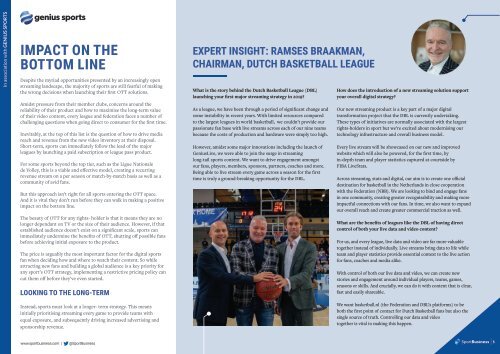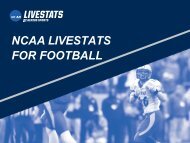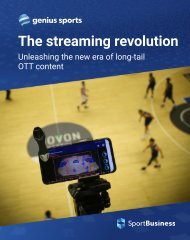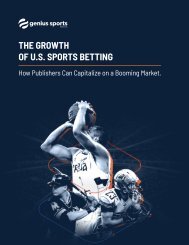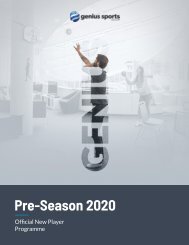SportBusiness Streaming Whitepaper Digital
Create successful ePaper yourself
Turn your PDF publications into a flip-book with our unique Google optimized e-Paper software.
In association with GENIUS SPORTS<br />
IMPACT ON THE<br />
BOTTOM LINE<br />
Despite the myriad opportunities presented by an increasingly open<br />
streaming landscape, the majority of sports are still fearful of making<br />
the wrong decisions when launching their first OTT solutions.<br />
Amidst pressure from their member clubs, concerns around the<br />
reliability of their product and how to maximise the long-term value<br />
of their video content, every league and federation faces a number of<br />
challenging questions when going direct to consumer for the first time.<br />
Inevitably, at the top of this list is the question of how to drive media<br />
reach and revenue from the new video inventory at their disposal.<br />
Short-term, sports can immediately follow the lead of the major<br />
leagues by launching a paid subscription or league pass product.<br />
For some sports beyond the top tier, such as the Ligue Nationale<br />
de Volley, this is a viable and effective model, creating a recurring<br />
revenue stream on a per season or match-by-match basis as well as a<br />
community of avid fans.<br />
But this approach isn’t right for all sports entering the OTT space.<br />
And it is vital they don’t run before they can walk in making a positive<br />
impact on the bottom line.<br />
The beauty of OTT for any rights- holder is that it means they are no<br />
longer dependant on TV or the size of their audience. However, if that<br />
established audience doesn’t exist on a significant scale, sports can<br />
immediately undermine the benefits of OTT, shutting off possible fans<br />
before achieving initial exposure to the product.<br />
The price is arguably the most important factor for the digital sports<br />
fan when deciding how and where to watch their content. So while<br />
attracting new fans and building a global audience is a key priority for<br />
any sport’s OTT strategy, implementing a restrictive pricing policy can<br />
cut them off before they’ve even started.<br />
LOOKING TO THE LONG-TERM<br />
EXPERT INSIGHT: RAMSES BRAAKMAN,<br />
CHAIRMAN, DUTCH BASKETBALL LEAGUE<br />
What is the story behind the Dutch Basketball League (DBL)<br />
launching your first major streaming strategy in 2019?<br />
As a league, we have been through a period of significant change and<br />
some instability in recent years. With limited resources compared<br />
to the largest leagues in world basketball, we couldn’t provide our<br />
passionate fan base with live streams across each of our nine teams<br />
because the costs of production and hardware were simply too high.<br />
However, amidst some major innovations including the launch of<br />
GeniusLive, we were able to join the surge in streaming<br />
long-tail sports content. We want to drive engagement amongst<br />
our fans, players, members, sponsors, partners, coaches and more.<br />
Being able to live stream every game across a season for the first<br />
time is truly a ground-breaking opportunity for the DBL.<br />
How does the introduction of a new streaming solution support<br />
your overall digital strategy?<br />
Our new streaming product is a key part of a major digital<br />
transformation project that the DBL is currently undertaking.<br />
These types of initiatives are normally associated with the largest<br />
rights-holders in sport but we’re excited about modernising our<br />
technology infrastructure and overall business model.<br />
Every live stream will be showcased on our new and improved<br />
website which will also be powered, for the first time, by<br />
in-depth team and player statistics captured at courtside by<br />
FIBA LiveStats.<br />
Across streaming, stats and digital, our aim is to create one official<br />
destination for basketball in the Netherlands in close cooperation<br />
with the Federation (NBB). We are looking to bind and engage fans<br />
in one community, creating greater recognisability and making more<br />
impactful connections with our fans. In time, we also want to expand<br />
our overall reach and create greater commercial traction as well.<br />
What are the benefits of leagues like the DBL of having direct<br />
control of both your live data and video content?<br />
For us, and every league, live data and video are far more valuable<br />
together instead of individually. Live streams bring data to life while<br />
team and player statistics provide essential context to the live action<br />
for fans, coaches and media alike.<br />
With control of both our live data and video, we can create new<br />
stories and engagement around individual players, teams, games,<br />
seasons or skills. And crucially, we can do it with content that is clear,<br />
fast and easily shareable.<br />
Instead, sports must look at a longer- term strategy. This means<br />
initially prioritising streaming every game to provide teams with<br />
equal exposure, and subsequently driving increased advertising and<br />
sponsorship revenue.<br />
We want basketball.nl (the Federation and DBL’s platforms) to be<br />
both the first point of contact for Dutch Basketball fans but also the<br />
single source of truth. Controlling our data and video<br />
together is vital to making this happen.<br />
www.sportbusiness.com | @<strong>SportBusiness</strong> 5


